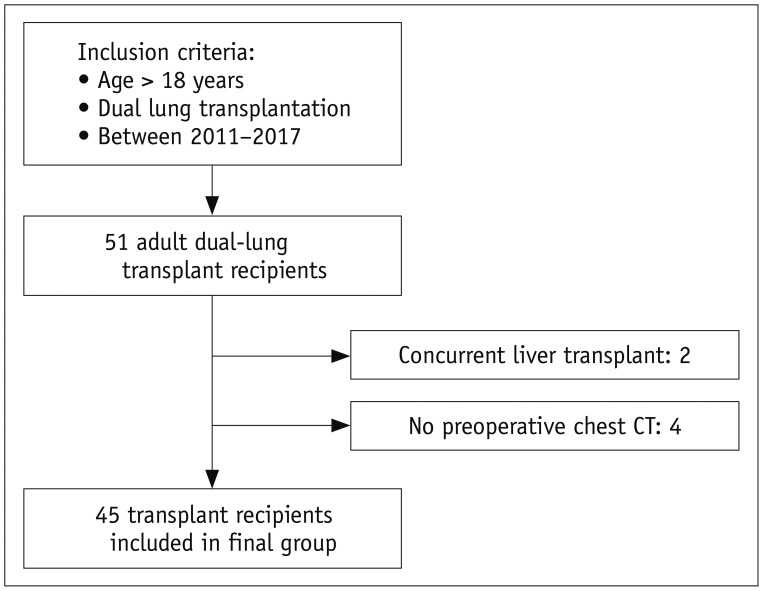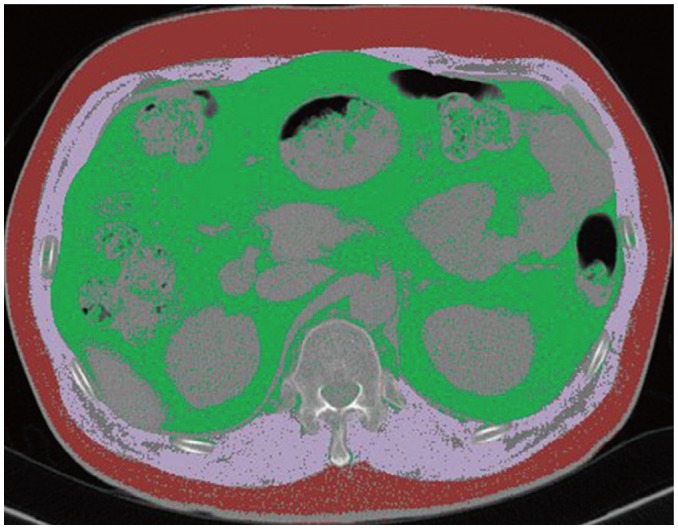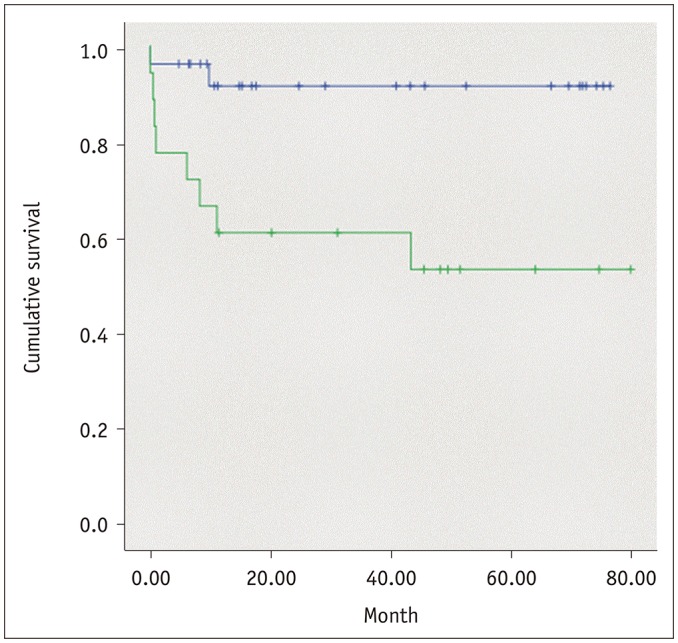Korean J Radiol.
2019 Mar;20(3):522-530. 10.3348/kjr.2018.0241.
Association of Chest CT-Based Quantitative Measures of Muscle and Fat with Post-Lung Transplant Survival and Morbidity: A Single Institutional Retrospective Cohort Study in Korean Population
- Affiliations
-
- 1Department of Radiology and Research Institute of Radiology, Asan Medical Center, University of Ulsan College of Medicine, Seoul, Korea. dokh@amc.seoul.kr
- 2Department of Thoracic and Cardiovascular Surgery, Asan Medical Center, University of Ulsan College of Medicine, Seoul, Korea.
- 3Division of Pulmonary and Critical Care Medicine, Asan Medical Center, University of Ulsan College of Medicine, Seoul, Korea.
- 4Department of Infectious Disease, Asan Medical Center, University of Ulsan College of Medicine, Seoul, Korea.
- KMID: 2438283
- DOI: http://doi.org/10.3348/kjr.2018.0241
Abstract
OBJECTIVE
Abnormal body composition is an important modifiable risk factor in lung transplantation. Therefore, precise quantification of different body components, including muscle and fat, may play an important role in optimizing outcomes in lung transplant patients. The purpose of the study was to investigate the prognostic significance of muscle and subcutaneous fat mass measured on chest CT with regard to lung transplantation survival and other post-transplant outcomes.
MATERIALS AND METHODS
The study population included 45 consecutive adult lung transplant recipients (mean age of 47.9 ± 12.1 years; 31 males and 14 females) between 2011 and 2017. Preoperative cross-sectional areas of muscle and subcutaneous fat were semi-automatically measured on axial CT images at the level of the 12th thoracic vertebra (T12). Additional normalized indexed parameters, adjusted for either height or weight, were obtained. Associations of quantitative parameters with survival and various other post-transplant outcomes were evaluated.
RESULTS
Of the 45 patients included in the present study, 10 mortalities were observed during the follow-up period. Patients with relative sarcopenia (RS) classified based on height-adjusted muscle area with a cut-off value of 28.07 cm²/m² demonstrated worse postoperative survival (log-rank test, p = 0.007; hazard ratio [HR], 6.39:1) despite being adjusted for age, sex, and body mass index (HR, 8.58:1; p = 0.022). Weight-adjusted parameters of muscle area were negatively correlated with duration of ventilator support (R = −0.54, p < 0.001) and intensive care unit (ICU) stay (R = −0.33, p = 0.021).
CONCLUSION
Patients with RS demonstrate worse survival after lung transplantation that those without RS. Additionally, quantitative parameters of muscles measured at the T12 level on chest CT were associated with the duration of post-lung transplant ventilator support and duration of stay in the ICU.
Keyword
MeSH Terms
Figure
Reference
-
1. Toronto Lung Transplant Group. Unilateral lung transplantation for pulmonary fibrosis. N Engl J Med. 1986; 314:1140–1145. PMID: 3515192.2. Yusen RD, Edwards LB, Kucheryavaya AY, Benden C, Dipchand AI, Goldfarb SB, et al. The registry of the International Society for Heart and Lung Transplantation: thirty-second official adult lung and heart-lung transplantation report--2015; Focus theme: early graft failure. J Heart Lung Transplant. 2015; 34:1264–1277. PMID: 26454740.
Article3. Haam SJ, Lee DY, Paik HC. An overview of lung transplantation in Korea. Transplant Proc. 2008; 40:2620–2622. PMID: 18929819.
Article4. Thabut G, Mal H. Outcomes after lung transplantation. J Thorac Dis. 2017; 9:2684–2691. PMID: 28932576.
Article5. Paik HC, Haam SJ, Lee DY, Yi GJ, Song SW, Kim YT, et al. The fate of patients on the waiting list for lung transplantation in Korea. Transplant Proc. 2012; 44:865–869. PMID: 22564569.
Article6. Egan TM, Murray S, Bustami RT, Shearon TH, McCullough KP, Edwards LB, et al. Development of the new lung allocation system in the United States. Am J Transplant. 2006; 6(5 Pt 2):1212–1227. PMID: 16613597.
Article7. Madill J, Gutierrez C, Grossman J, Allard J, Chan C, Hutcheon M, et al. Nutritional assessment of the lung transplant patient: body mass index as a predictor of 90-day mortality following transplantation. J Heart Lung Transplant. 2001; 20:288–296. PMID: 11257554.
Article8. Singer JP, Peterson ER, Snyder ME, Katz PP, Golden JA, D'Ovidio F, et al. Body composition and mortality after adult lung transplantation in the United States. Am J Respir Crit Care Med. 2014; 190:1012–1021. PMID: 25233138.
Article9. Englesbe MJ, Patel SP, He K, Lynch RJ, Schaubel DE, Harbaugh C, et al. Sarcopenia and mortality after liver transplantation. J Am Coll Surg. 2010; 211:271–278. PMID: 20670867.
Article10. Streja E, Molnar MZ, Kovesdy CP, Bunnapradist S, Jing J, Nissenson AR, et al. Associations of pretransplant weight and muscle mass with mortality in renal transplant recipients. Clin J Am Soc Nephrol. 2011; 6:1463–1473. PMID: 21415312.
Article11. Hook JL, Lederer DJ. Selecting lung transplant candidates: where do current guidelines fall short? Expert Rev Respir Med. 2012; 6:51–61. PMID: 22283579.
Article12. Kyle UG, Nicod L, Romand JA, Slosman DO, Spiliopoulos A, Pichard C. Four-year follow-up of body compostion in lung transplant patients. Transplantation. 2003; 75:821–828. PMID: 12660509.
Article13. Lee S, Paik HC, Haam SJ, Lee CY, Nam KS, Jung HS, et al. Sarcopenia of thoracic muscle mass is not a risk factor for survival in lung transplant recipients. J Thorac Dis. 2016; 8:2011–2017. PMID: 27621854.
Article14. Maury G, Langer D, Verleden G, Dupont L, Gosselink R, Decramer M, et al. Skeletal muscle force and functional exercise tolerance before and after lung transplantation: a cohort study. Am J Transplant. 2008; 8:1275–1281. PMID: 18444941.
Article15. Rozenberg D, Mathur S, Herridge M, Goldstein R, Schmidt H, Chowdhury NA, et al. Thoracic muscle cross-sectional area is associated with hospital length of stay post lung transplantation: a retrospective cohort study. Transpl Int. 2017; 30:713–724. PMID: 28390073.
Article16. Rozenberg D, Wickerson L, Singer LG, Mathur S. Sarcopenia in lung transplantation: a systematic review. J Heart Lung Transplant. 2014; 33:1203–1212. PMID: 25044057.
Article17. Camus V, Lanic H, Kraut J, Modzelewski R, Clatot F, Picquenot JM, et al. Prognostic impact of fat tissue loss and cachexia assessed by computed tomography scan in elderly patients with diffuse large B-cell lymphoma treated with immunochemotherapy. Eur J Haematol. 2014; 93:9–18.
Article18. Lee SJ, Ryu YJ, Lee JH, Chang JH, Shim SS. The impact of low subcutaneous fat in patients with nontuberculous mycobacterial lung disease. Lung. 2014; 192:395–401. PMID: 24549334.
Article19. Kyle UG, Genton L, Mentha G, Nicod L, Slosman DO, Pichard C. Reliable bioelectrical impedance analysis estimate of fat-free mass in liver, lung, and heart transplant patients. JPEN J Parenter Enteral Nutr. 2001; 25:45–51. PMID: 11284469.
Article20. Cruz-Jentoft AJ, Baeyens JP, Bauer JM, Boirie Y, Cederholm T, Landi F, et al. Sarcopenia: European consensus on definition and diagnosis: report of the European Working Group on sarcopenia in older people. Age Ageing. 2010; 39:412–423. PMID: 20392703.
Article21. Mourtzakis M, Prado CM, Lieffers JR, Reiman T, McCargar LJ, Baracos VE. A practical and precise approach to quantification of body composition in cancer patients using computed tomography images acquired during routine care. Appl Physiol Nutr Metab. 2008; 33:997–1006. PMID: 18923576.
Article22. Pamoukdjian F, Bouillet T, Lévy V, Soussan M, Zelek L, Paillaud E. Prevalence and predictive value of pre-therapeutic sarcopenia in cancer patients: a systematic review. Clin Nutr. 2018; 37:1101–1113. PMID: 28734552.
Article23. Kim EY, Kim YS, Park I, Ahn HK, Cho EK, Jeong YM, et al. Evaluation of sarcopenia in small-cell lung cancer patients by routine chest CT. Support Care Cancer. 2016; 24:4721–4726. PMID: 27364150.
Article24. Nemec U, Heidinger B, Sokas C, Chu L, Eisenberg RL. Diagnosing sarcopenia on thoracic computed tomography: quantitative assessment of skeletal muscle mass in patients undergoing transcatheter aortic valve replacement. Acad Radiol. 2017; 24:1154–1161. PMID: 28365235.25. Tong Y, Udupa JK, Torigian DA, Odhner D, Wu C, Pednekar G, et al. Chest fat quantification via CT based on standardized anatomy space in adult lung transplant candidates. PLoS One. 2017; 12:e0168932. PMID: 28046024.
Article26. Meng NH, Li CI, Liu CS, Lin WY, Lin CH, Chang CK, et al. Sarcopenia defined by combining height- and weight-adjusted skeletal muscle indices is closely associated with poor physical performance. J Aging Phys Act. 2015; 23:597–606. PMID: 25562330.
Article27. Budczies J, Klauschen F, Sinn BV, Gyo”rffy B, Schmitt WD, Darb-Esfahani S, et al. Cutoff Finder: a comprehensive and straightforward Web application enabling rapid biomarker cutoff optimization. PLoS One. 2012; 7:e51862. PMID: 23251644.
Article28. Malietzis G, Aziz O, Bagnall NM, Johns N, Fearon KC, Jenkins JT. The role of body composition evaluation by computerized tomography in determining colorectal cancer treatment outcomes: a systematic review. Eur J Surg Oncol. 2015; 41:186–196. PMID: 25468746.
Article29. Cruz RJ Jr, Dew MA, Myaskovsky L, Goodpaster B, Fox K, Fontes P, et al. Objective radiologic assessment of body composition in patients with end-stage liver disease: going beyond the BMI. Transplantation. 2013; 95:617–622. PMID: 23348896.30. DiMartini A, Cruz RJ Jr, Dew MA, Myaskovsky L, Goodpaster B, Fox K, et al. Muscle mass predicts outcomes following liver transplantation. Liver Transpl. 2013; 19:1172–1180. PMID: 23960026.
Article31. Krell RW, Kaul DR, Martin AR, Englesbe MJ, Sonnenday CJ, Cai S, et al. Association between sarcopenia and the risk of serious infection among adults undergoing liver transplantation. Liver Transpl. 2013; 19:1396–1402. PMID: 24151041.
Article32. Kelm DJ, Bonnes SL, Jensen MD, Eiken PW, Hathcock MA, Kremers WK, et al. Pre-transplant wasting (as measured by muscle index) is a novel prognostic indicator in lung transplantation. Clin Transplant. 2016; 30:247–255. PMID: 26701203.
Article33. Weig T, Milger K, Langhans B, Janitza S, Sisic A, Kenn K, et al. Core muscle size predicts postoperative outcome in lung transplant candidates. Ann Thorac Surg. 2016; 101:1318–1325. PMID: 26794887.
Article34. Jeong YH, Choi S, Park SI, Kim DK. Asan Medical Center Lung Transplantation Team. Clinical outcomes of lung transplantation: experience at Asan Medical Center. Korean J Thorac Cardiovasc Surg. 2018; 51:22–28. PMID: 29430425.
Article35. Prado CM, Lieffers JR, McCargar LJ, Reiman T, Sawyer MB, Martin L, et al. Prevalence and clinical implications of sarcopenic obesity in patients with solid tumours of the respiratory and gastrointestinal tracts: a population-based study. Lancet Oncol. 2008; 9:629–635. PMID: 18539529.
Article36. Shen W, Punyanitya M, Wang Z, Gallagher D, St-Onge MP, Albu J, et al. Total body skeletal muscle and adipose tissue volumes: estimation from a single abdominal cross-sectional image. J Appl Physiol (1985). 2004; 97:2333–2338. PMID: 15310748.
Article37. Oh JK, Ahn MI, Kim HL, Park SH, Shin E. Retrodiaphragmatic portion of the lung: how deep is the posterior costophrenic sulcus on posteroanterior chest radiography? Clin Radiol. 2009; 64:786–791. PMID: 19589417.
Article
- Full Text Links
- Actions
-
Cited
- CITED
-
- Close
- Share
- Similar articles
-
- Lung Cancer in the Explanted Lung of the Recipient in Lung Transplantation
- Cohort Study
- Incidence of Post-transplant Malignancy after Renal Transplantation: Single Center Analysis
- Associations between Weight-Adjusted Waist Index and Abdominal Fat and Muscle Mass: Multi-Ethnic Study of Atherosclerosis
- The effect of a recipient’s body mass index to kidney transplantation outcomes: a retrospective cohort study at National Kidney and Transplant Institute




